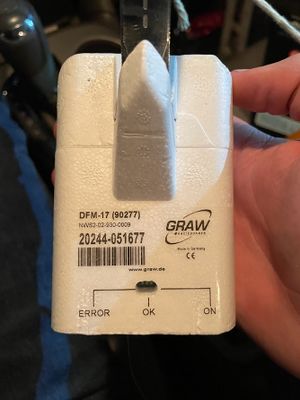DFM-17 Radiosonde
The DFM-17 is a balloon-launched radiosonde manufactured by GRAW Radiosondes GmbH & Co. KG, and used for meteorological sounding.
Overview
The DFM-17 radiosonde succeeds the DFM-09 radiosonde. Graw began a contract with NOAA in the US to provide radiosondes. As of Late 2021, several sites have made the transition as part of NOAA’s Operational Test and Evaluation (OT&E) program. 45 CONUS sites are expected to use these radiosondes in early 2022. [1]
Specs [2]
- Weight: 63g
- Size: 90 x 67 x 44 mm
- Power supply: 2 CR123A batteries
- Estimated runtime: ~240 minutes
- Transmission rate: 1 packet/sec
- Bandwidth: ~10 kHz (Website lists <12)
- Frequency range: 400 - 405.99 MHz
- Modulation: GFSK
- TX Power: ~100mW
- Error Correction: Code-spreading, interleaving
- SoC: STM32F100R8T6B, 24MHz, 8KB RAM, 64KB Flash
- GPS: Ublox MAX-M8C-0-10
- Transmitter: Si4063
Photos
Disassembly
- Examine rope, parachute and parachute rigging lines for viability. Neatly organize the flight rigging if usable. Discard if not viable for reuse.
- Cut the zip tie surrounding the Styrofoam from the top portion by the rope loop.
- Pull the rope loop out, there should be little to no resistance.
- Make a slice in the sticker[3] where the two pieces of Styrofoam meet.
- Pull apart the two Styrofoam pieces to reveal the circuit board.
- Pull the circuit board out. There will be some resistance.
- The board is now separated from the Styrofoam shell, reuse if desired.
- Pull the two CR123A batteries out, keep or discard them. The board can run off USB power. Batteries are not necessary for development on this board.
Reassembly
- Insert two fresh CR123A batteries into the board.
- Line up the board to the IO cutouts in the Styrofoam, begin to push into the slots. Make sure the antenna wire comes through.
- Press the top piece of Styrofoam into place.
- Tape or apply another sticker onto the back label. (Optional)
- Insert the plastic rope loop piece.
- zip tie the shell together, the zip tie end should end up on the edge nearest to the power button.
- Rope on a balloon/drone/kite/etc.. to the rope loop.
- Power on the device by pressing the button.
Developing and Programming the board
When lab testing, you can power the board from the USB header. It also appears to run fine supplying 3.3V to the SWD port.
The board uses a STM32, and requires a ST-Link to program. The process used to upload code to the MCU is the same as the Vaisala RS41 radiosonde, you will need to solder and connect the VTRef(3.3V), Ground, SWDIO and SWDCLK pins to your ST-Link.
- ↑ GRAW delivers to USA NOAA/National Weather Service. GRAW Radiosondes GmbH & Co. KG. Retrieved 17 November 2021.
- ↑ https://www.graw.de/products/radiosondes/dfm-17/
- ↑ File:DFM-17 NOAA Label.jpg
